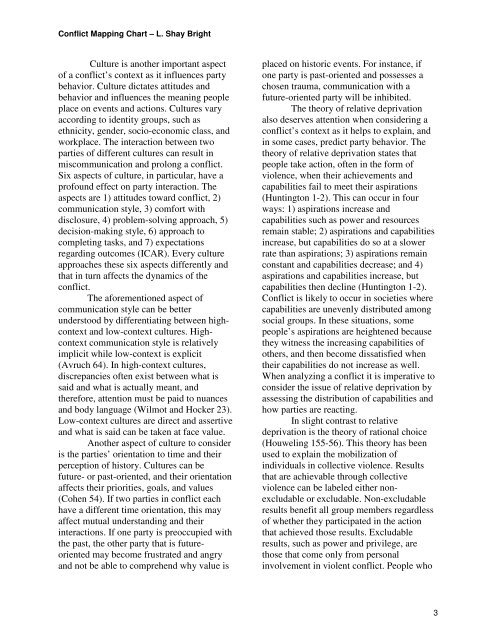The Conflict Mapping Chart By L. Shay Bright To ... - CMSupport.org
The Conflict Mapping Chart By L. Shay Bright To ... - CMSupport.org
The Conflict Mapping Chart By L. Shay Bright To ... - CMSupport.org
Create successful ePaper yourself
Turn your PDF publications into a flip-book with our unique Google optimized e-Paper software.
<strong>Conflict</strong> <strong>Mapping</strong> <strong>Chart</strong> – L. <strong>Shay</strong> <strong>Bright</strong><br />
Culture is another important aspect<br />
of a conflict’s context as it influences party<br />
behavior. Culture dictates attitudes and<br />
behavior and influences the meaning people<br />
place on events and actions. Cultures vary<br />
according to identity groups, such as<br />
ethnicity, gender, socio-economic class, and<br />
workplace. <strong>The</strong> interaction between two<br />
parties of different cultures can result in<br />
miscommunication and prolong a conflict.<br />
Six aspects of culture, in particular, have a<br />
profound effect on party interaction. <strong>The</strong><br />
aspects are 1) attitudes toward conflict, 2)<br />
communication style, 3) comfort with<br />
disclosure, 4) problem-solving approach, 5)<br />
decision-making style, 6) approach to<br />
completing tasks, and 7) expectations<br />
regarding outcomes (ICAR). Every culture<br />
approaches these six aspects differently and<br />
that in turn affects the dynamics of the<br />
conflict.<br />
<strong>The</strong> aforementioned aspect of<br />
communication style can be better<br />
understood by differentiating between highcontext<br />
and low-context cultures. Highcontext<br />
communication style is relatively<br />
implicit while low-context is explicit<br />
(Avruch 64). In high-context cultures,<br />
discrepancies often exist between what is<br />
said and what is actually meant, and<br />
therefore, attention must be paid to nuances<br />
and body language (Wilmot and Hocker 23).<br />
Low-context cultures are direct and assertive<br />
and what is said can be taken at face value.<br />
Another aspect of culture to consider<br />
is the parties’ orientation to time and their<br />
perception of history. Cultures can be<br />
future- or past-oriented, and their orientation<br />
affects their priorities, goals, and values<br />
(Cohen 54). If two parties in conflict each<br />
have a different time orientation, this may<br />
affect mutual understanding and their<br />
interactions. If one party is preoccupied with<br />
the past, the other party that is futureoriented<br />
may become frustrated and angry<br />
and not be able to comprehend why value is<br />
placed on historic events. For instance, if<br />
one party is past-oriented and possesses a<br />
chosen trauma, communication with a<br />
future-oriented party will be inhibited.<br />
<strong>The</strong> theory of relative deprivation<br />
also deserves attention when considering a<br />
conflict’s context as it helps to explain, and<br />
in some cases, predict party behavior. <strong>The</strong><br />
theory of relative deprivation states that<br />
people take action, often in the form of<br />
violence, when their achievements and<br />
capabilities fail to meet their aspirations<br />
(Huntington 1-2). This can occur in four<br />
ways: 1) aspirations increase and<br />
capabilities such as power and resources<br />
remain stable; 2) aspirations and capabilities<br />
increase, but capabilities do so at a slower<br />
rate than aspirations; 3) aspirations remain<br />
constant and capabilities decrease; and 4)<br />
aspirations and capabilities increase, but<br />
capabilities then decline (Huntington 1-2).<br />
<strong>Conflict</strong> is likely to occur in societies where<br />
capabilities are unevenly distributed among<br />
social groups. In these situations, some<br />
people’s aspirations are heightened because<br />
they witness the increasing capabilities of<br />
others, and then become dissatisfied when<br />
their capabilities do not increase as well.<br />
When analyzing a conflict it is imperative to<br />
consider the issue of relative deprivation by<br />
assessing the distribution of capabilities and<br />
how parties are reacting.<br />
In slight contrast to relative<br />
deprivation is the theory of rational choice<br />
(Houweling 155-56). This theory has been<br />
used to explain the mobilization of<br />
individuals in collective violence. Results<br />
that are achievable through collective<br />
violence can be labeled either nonexcludable<br />
or excludable. Non-excludable<br />
results benefit all group members regardless<br />
of whether they participated in the action<br />
that achieved those results. Excludable<br />
results, such as power and privilege, are<br />
those that come only from personal<br />
involvement in violent conflict. People who<br />
3


